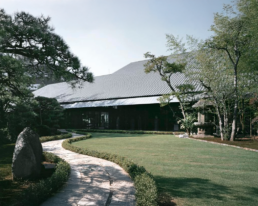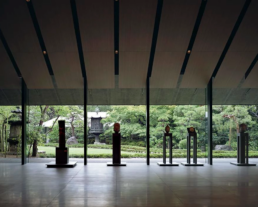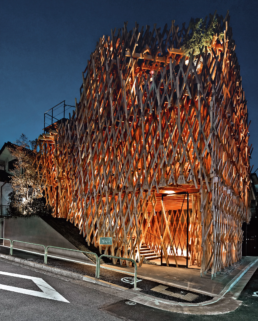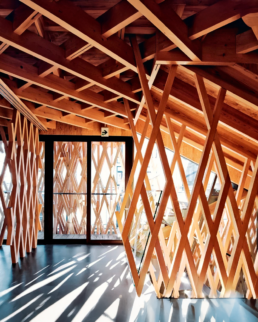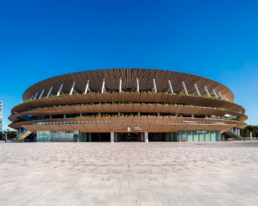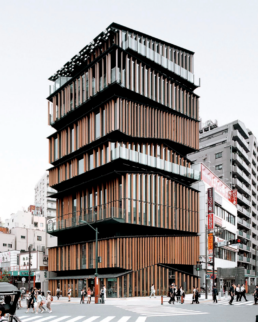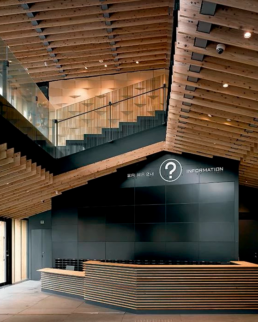Which Kengo Kuma projects can you visit if you travel to Japan?
DATE
31.03.2025
If you travel to Japan and are passionate about architecture, visiting Kengo Kuma’s projects is a must.
Internationally acclaimed for his ability to merge contemporary architecture with traditional materials and the natural landscape, Kuma has created an impressive series of works that reflect his innovative architectural vision. One of the most iconic projects you can visit is the Nezu Museum of Design in Tokyo. Opened in 2009, this museum is one of Kuma’s most recognized works, blending natural materials like wood and glass to create an atmosphere of serenity and harmony. Surrounded by gardens that seamlessly connect with the architecture, the museum’s design reflects a minimalist aesthetic that also respects Japanese architectural traditions. This project is not only a testament to his mastery but also an homage to Japanese art and design, fusing the building with its environment in a way few architects achieve.
Another remarkable Kengo Kuma project you can explore is Sunny Hills in Tokyo, a building that exemplifies his innovative approach to sustainable architecture and traditional materials. This pineapple cake store, run by the Sunny Hills brand, is notable for its unique structure made almost entirely of wood, giving it a special warmth and a deep connection with nature. The building’s wooden envelope curves and stretches along the façade, creating a dynamic play of light and shadow that changes throughout the day. Wood, a recurring material in Kuma’s work, serves not only an aesthetic purpose but also an ecological one, contributing to the building’s sustainability. Its form, inspired by the fluidity of nature, and its integration into the urban fabric of Tokyo make this project a contemporary architectural masterpiece. The interior is equally impressive, with an open, minimalist space that reflects Kuma’s focus on creating sensory experiences through architecture.
One of Kuma’s most impressive works in Japan is the Japan National Stadium in Tokyo, designed for the 2020 Olympic Games. This project combines modernity, functionality, and a deep respect for Japanese tradition. Kuma’s design for the stadium emphasizes integration with the surrounding nature and a strong focus on sustainability. Using materials like wood and greenery, the stadium visually connects with Shinjuku Gyoen National Garden, creating a unique atmosphere where sport and nature coexist in harmony. The stadium’s structure, with its fluid and organic appearance, is not only impressive in scale and capacity but also designed to adapt to various types of events and to offer a unique experience to the public. The use of wood on the façade and roof, along with the open stands and rooftop gardens, gives the stadium a feeling of lightness and openness, breaking with the rigidity typically seen in large sports venues. Visiting the National Stadium is stepping into a work that reflects Kuma’s vision of combining modernity with traditional Japanese values in a space that connects people to nature through sport and culture.
In Japan, you can also visit one of Kuma’s most nationally emblematic projects: the Asakusa Culture and Tourism Center in Tokyo, completed in 2012. This cultural and tourist center is a masterpiece that uniquely blends the modern with the traditional. Located near the historic Sensō-ji Temple in the Asakusa district, the center’s design is characterized by its use of wood, stone, and glass, creating an atmosphere that dialogues with the site’s history. The building’s façade features a series of geometric forms that evoke traditional Japanese temple structures, while the interior, with its open and bright spaces, offers a modern and functional experience. The building serves not only as an architectural landmark but also as a welcoming space for tourists and visitors, adapting to the needs of the local community and providing a meeting point between past and future. Visiting this center is stepping into a contemporary interpretation of Japanese heritage, a recurring theme in Kuma’s work, where he always seeks a balance between modernity and tradition in his designs.
MArch Valencia. Arquitectura y Diseño
© 2025 MArch Valencia. Arquitectura y Diseño
Privacy policy | Cookies policy | Terms of use
